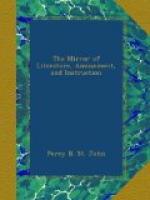“There, said I to myself, lie, scarcely one foot beneath the surface of a swelling soil, ready to burst at every point with its festering contents, more than half the generations whom death has continued to mow down for nearly four centuries in the vast capital of Islamism. There lie, side by side, on the same level, in cells the size of their bodies, and only distinguished by a marble turban somewhat longer or deeper—somewhat rounder or squarer—personages, in life, far as heaven and earth asunder, in birth, in station, in gifts of nature, and in long laboured acquirements. There lie, sunk alike in their last sleep—alike food for the worm that lives on death—the conqueror who filled the universe with his name, and the peasant scarcely known in his own hamlet; Sultan Mahmoud, and Sultan Mahmoud’s perhaps more deserving horse;[4] elders bending under the weight of years, and infants of a single hour; men with intellects of angels, and men with understandings inferior to those of brutes; the beauty of Georgia and the black of Sennaar; visiers, beggars, heroes, and women.’”
The approach to Constantinople from the sea of Marmora is likewise thus beautifully described by the same author, and will form an appropriate conclusion:
“With eyes rivetted on the expanding splendour, I watched as they came out of the bosom of the surrounding waters, the pointed minarets, the swelling cupolas, and the innumerable habitations, either stretching along the jagged shore, and reflecting their shape in the mirror of the deep, or creeping up the crested mountain, and tracing their outline on the expanse of the sky. At first agglomerated in a single confused mass, the lesser part of this immense whole seemed, as we advanced, by degrees to unfold, to disengage themselves from each other, and to grow into various groups, divided by wide chasms and deep indentures; until at last the clusters, thus far still distantly connected, became transformed, as if by magic, into three distinct cities, each individually of prodigious extent, and each separated from the other two by a wide arm of that sea whose silver tide encompassed their base, and made its vast circuit rest half on Europe, and half on Asia.”
Since writing the above we have visited Mr. Burford’s New Panorama of Constantinople, which has lately been opened for exhibition in the Strand; and although we cannot in this Number enter into the detail of its merits, we recommend it to our lionizing friends as one of Mr. Burford’s most finished paintings, and equal if not superior in effect to any exhibition in the metropolis; but we reserve an account of its pictorial beauties for our next publication.
[1] See “Sailing round Constantinople,”
Mirror, vol. x. p. 278. Engraving
and Description of the Castle
of the Seven Towers, ibid, vol. x.
p. 361. Extent of Constantinople,
vol. xi. p. 298. Lines on
Constantinople, vol. xii.
p. 58. Taking of the City by the Turks, vol.
xii. p. 274.




